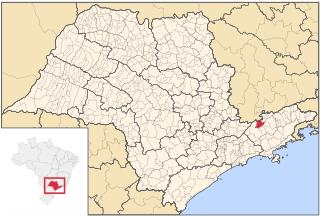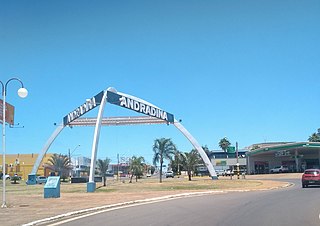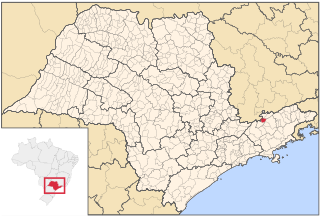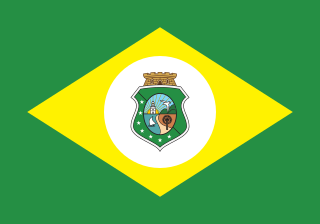
The following is a list of symbols of the Brazilian state of Tocantins .

The following is a list of symbols of the Brazilian state of Tocantins .
| Type | Symbol | Date | Image |
|---|---|---|---|
| Flag | Flag of Tocantins | 17 November 1989 [1] |  |
| Coat of arms | Coat of arms of Tocantins | 1 January 1989 [1] |  |
| Motto | Co yvy ore retama (Tupi: This land is ours) | ||
| Song | Anthem of Tocantins [2] | 30 April 1998 [3] |
| Type | Symbol | Date | Image |
|---|---|---|---|
| Flower | Sunflower [1] | 16 July 1997 [4] 9 August 2012 [5] |  |
| Tree | Fava de Bolota [1] | 16 July 1997 [4] 9 August 2012 [5] |  |
| Symbol | Date | Image |
|---|---|---|
| Blue-and-yellow macaw [1] | 16 July 1997 [4] [6] 9 August 2012 [5] |  |
| Scaled dove | 16 July 1997 [4] 9 August 2012 [5] |  |
| Type | Symbol | Date | Image |
|---|---|---|---|
| Stone | Garnet A3B2(SiO4)3 | 16 July 1997 [4] 9 August 2012 [5] |  |

Bertioga is a Brazilian municipality in the state of São Paulo and part of the Baixada Santista Metropolitan Region. Its population is 64,723 in an area of 490.15 km2. Because it neighbors resort towns, its population fluctuates greatly with the seasons. The more northern parts are densely forested and humanly unpopulated. It was created on 19 May 1991, from a part of Santos.

Monteiro Lobato is a municipality in the state of São Paulo in Brazil. It is part of the Metropolitan Region of Vale do Paraíba e Litoral Norte. The population is 4,696 in an area of 332.74 km2 (128.47 sq mi).

Andradina is a municipality of the state of São Paulo, Brazil.

Santo Antônio do Pinhal is a municipality in the state of São Paulo in Brazil. It is part of the Metropolitan Region of Vale do Paraíba e Litoral Norte. The population is 6,827 in an area of 133.01 km². The elevation is 1,080 m (3543 ft). It is situated near Campos do Jordão, some 150 km away from São Paulo.

Anti-discrimination laws in Brazil are present in the Constitution of Brazil, in the labour law, in the child and adolescent law, in the ageing law, and in the penal code.

The administrative regions of the Federal District are administrative divisions of the Federal District, Brazil. They have similar jurisdiction to municipalities, albeit with a much lesser degree of autonomy. However, administrators are not directly elected, but appointed by the Governor of the Federal District. Moreover, administrative regions have no specific legislative representation apart from the district-wide Legislative Chamber of the Federal District.

The flag of the state of São Paulo, Brazil, serves as one of the state's symbols, along with the state's coat of arms and anthem. It was designed by the philologist and writer Júlio Ribeiro in 1888, with his brother-in-law, Amador Amaral, a graphic artist. The flag has thirteen black and white stripes and a red rectangle in the upper left corner holding a white circle enclosing an outline map of Brazil in blue. There is a yellow star in each corner of the red rectangle.

Eduardo Figueiredo Cavalheiro Leite is a Brazilian politician and governor of the state of Rio Grande do Sul. During the state's 2018 election, he won with 53.62% of the vote. Leite was elected governor at 33 years old, becoming the youngest governor in Brazil. In July 2021, Leite came out as gay during an interview for the Brazilian talk show Conversa com Bial, becoming the first openly gay governor in Brazil's history, and second openly LGBT governor in Brazil after Fátima Bezerra of Rio Grande do Norte.

São Caetano do Sul-Prefeito Walter Braido, unofficially called only as São Caetano or São Caetano do Sul, is a train station on CPTM Line 10-Turquoise.

The governor of Rio Grande do Sul is the head of government of the state's executive branch, assisted by his secretaries, whom he freely chooses. Elected by absolute majority in universal suffrage, together with the vice-governor, his term lasts four years; since 1997, reelection has been possible, and although all have sought it, none has succeeded. The current governor is Eduardo Leite, since January 1, 2023.
The politics of Pernambuco is the direction of Pernambuco's territory and the determination of the powers that make up its government structure. It is governed by three branches, the executive, the legislative, and the judiciary, and its current constitution was enacted on October 5, 1989; the first constitution was enacted in 1891 and after that there were three others.

The flag of Ceará is the official flag of the Brazilian state of Ceará. The original version of the flag was adopted on 25 August 1922 by state decree 1,971 of Ceará.